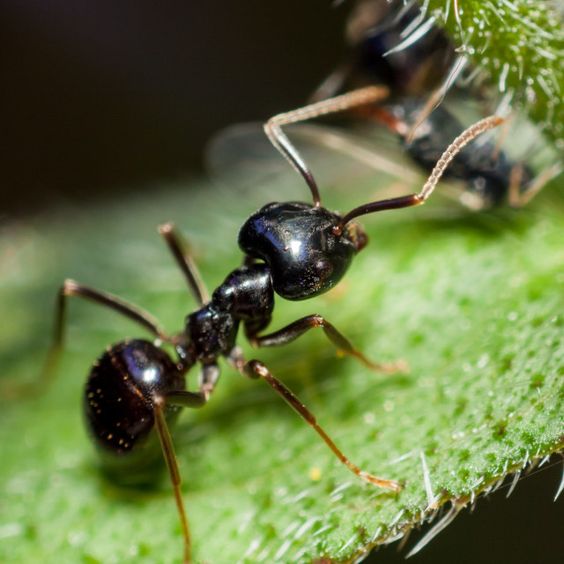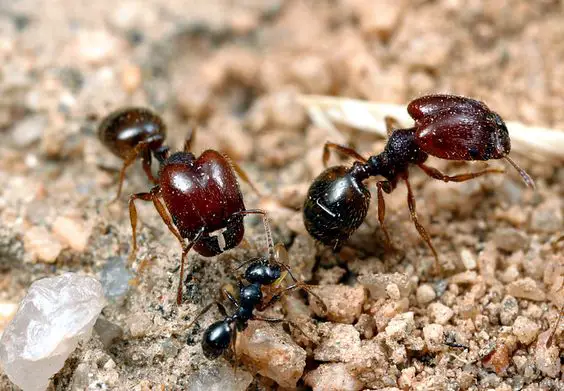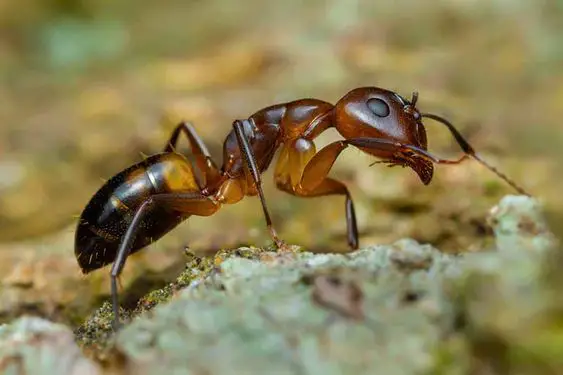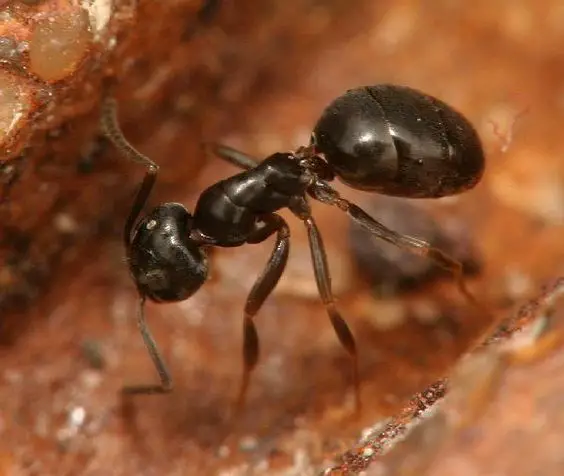Did you know that California is home to over 270 species of ants?
From the bustling cities to the serene wilderness, these tiny insects are everywhere, shaping ecosystems and influencing our daily lives in surprising ways.
Ants are more than just pests; they’re nature’s cleanup crew, soil aerators, and even gardeners.
Types Of Ants in California
California is home to a diverse array of ant species, each with its unique characteristics and ecological role. Here are some of the most common types of ants found in California.
Little Black Ant

Little black ants in California are a common sight, both in homes and outdoors.
- Size & Color: Little black ants, true to their name, are incredibly tiny, measuring a mere 2-3 mm in length. Their bodies are typically a deep black or dark brown color, with a slightly shiny appearance.
- Habitat: California’s diverse landscapes provide ample habitats for these adaptable insects. From the bustling city streets to the tranquil forests, little black ants can be found thriving in a variety of environments.
- Biodiversity: Little black ants are a remarkably diverse group of insects, with over 1,200 species identified worldwide.
- Complications: While little black ants may not pose a direct threat to human health, their presence in homes can be a nuisance and a potential health hazard.
- Impact: The ecological impact of little black ants is far from negligible. Their voracious appetites can lead to damage to crops and trees.
Red Imported Fire Ants in California

Red Imported Fire Ants (Solenopsis invicta) are invasive ants that have made themselves at home in many parts of the United States, causing trouble for both humans and native wildlife.
- Size & Color: Red imported fire ants, also known as Solenopsis invicta, are not the largest ant species. They are typically about 2-6mm in length, with reddish-brown bodies, black heads.
- Habitat: Red imported fire ants are found in warm, moist environments, and they thrive in disturbed areas such as lawns, gardens, and agricultural fields.
- Biodiversity: Red imported fire ants are native to South America, but they have been accidentally introduced to many parts of the world, including California.
- Complications: Red imported fire ants are a significant nuisance to humans. Their aggressive behavior and painful bites can make them a hazard in homes, yards, and parks.
- Impact: Red imported fire ants have a significant impact on the environment. They are voracious predators of insects, including beneficial ones such as ladybugs and earthworms.
California Harvester Ants

California Harvester Ants (Pogonomyrmex spp.) are a fascinating and beneficial part of California’s ecosystem.
- Size & Color: California harvester ants are medium-sized ants, measuring about 1/4 to 1/2 inch in length. They are typically a reddish-brown color, with a slightly shiny appearance.
- Habitat: California harvester ants are found in a variety of habitats, including grasslands, deserts, and forests.
- Biodiversity: There are over 20 species of harvester ants in California, each with its own unique characteristics.
- Complications: California harvester ants can be a nuisance in some areas, as they can damage crops and gardens. They can also be a problem in homes, as they may forage for food in kitchens and other areas.
- Impact: California harvester ants play an important role in the ecosystem. They help to disperse seeds and control pest populations. They are also a food source for many other animals, such as birds, lizards, and snakes.
Velvety Tree Ants

Velvety tree ants, scientifically known as Liometopum occidentale.
- Size & Color: They are small insects, measuring about 1/16 to 1/4 inch in length. They have a black and red coloration, with black abdomens, reddish-brown thoraxes, and brown heads.Their bodies are covered with fine hairs that give them a velvety appearance.
- Habitat: Velvety tree ants are found throughout California, but they are most common in coastal areas. They typically nest in decaying wood, such as tree trunks, logs, and stumps.
- Biodiversity: Velvety tree ants are one of the most common ant species in California. They are a social insect, living in colonies of up to several thousand individuals.
- Complications: Velvety tree ants are not typically aggressive, but they can bite if they feel threatened. Their bites are not usually serious, but they can be painful.
- Impact: Velvety tree ants play an important role in the ecosystem. They help to decompose dead wood and recycle nutrients. They are also a food source for many other animals, such as birds, lizards, and snakes.
Western Harvester Ants

Western Harvester Ants are the small but diligent farmers of the insect world.
These ants are renowned for their distinctive behaviors, such as seed harvesting and mound-building.
- Size & Color: Measuring approximately 1/4 to 1/2 inch in length, western harvester ants are medium to large in size. Their color ranges from reddish-brown to black, with a slightly shiny appearance.
- Habitat: Western harvester ants are commonly found in grasslands, deserts, and foothills throughout California.
- Biodiversity: California alone boasts around 60 distinct species of harvester ants, each with unique adaptations and ecological roles.
- Complications: Western harvester ants can become a nuisance in agricultural areas, as they harvest and store large quantities of seeds, potentially impacting crop yields.
- Impact: Western harvester ants play a crucial role in the ecosystem. Their seed-harvesting behavior disperses seeds and contributes to plant regeneration.
Argentine Ants in California

Argentine ants, those minuscule but pesky invaders, are a common sight in California.
- Size & Color: Argentine ants are small, dark brown to black insects measuring about 1/16 to 1/8 inch in length.
- Habitat: Argentine ants are native to South America, but they have been introduced to many parts of the world, including California.
- Biodiversity: Argentine ants are considered a supercolony, meaning that multiple colonies have merged into a single, interconnected unit.
- Complications: Argentine ants are a significant nuisance to humans. They are known to invade homes and businesses, foraging for food and contaminating it with bacteria and pathogens.
- Impact: Argentine ants have a significant impact on the environment. They can also damage crops and trees, and they can disrupt the natural balance of ecosystems.
Odorous House Ants

Odorous house ants (Tapinoma sessile) are a common sight in homes across the United States, including California. Known for their distinct, foul odor—reminiscent of rotten coconut when crushed.
- Size & Color: Odorous house ants are tiny creatures, measuring just 2-3 mm in length. Their bodies are typically a deep black or dark brown color, with a slightly shiny appearance.
- Habitat: Odorous house ants are found throughout California, from the coast to the mountains. They prefer warm, moist environments and can be found in a variety of habitats.
- Biodiversity: Odorous house ants are a highly diverse group of insects. In California, there are over 200 species of odorous house ants, each with its own unique characteristics.
- Complications: While odorous house ants are not typically considered to be dangerous, they can be a nuisance in homes. They can contaminate food and spread bacteria.
- Impact: Odorous house ants can have a significant impact on the environment. They are known to damage crops and trees, and they can also disrupt the natural balance of ecosystems.
Pharaoh Ants

Pharaoh ants may not wear crowns, but they sure act like royalty in the ant kingdom.
- Size & Color: Pharaoh ants are very small ants, measuring only 1.5 to 2.5 mm in length. They are typically a light yellow to brown color, with slightly darker abdomens.
- Habitat: Pharaoh ants are native to tropical and subtropical regions, but they have been introduced to many parts of the world, including California.
- Biodiversity: There are over 20 species of Pharaoh ants, but only one species, Monomorium pharaonis, is typically found in the United States.
- Complications: Pharaoh ants can be a nuisance in homes and businesses. They can contaminate food and spread disease. Pharaoh ants can also be difficult to control, as they are very good at hiding and can recolonize quickly.
- Impact: Pharaoh ants can have a significant impact on the environment. They are known to damage crops and trees, and they can also disrupt the natural balance of ecosystems.
Conclusion
Ants in sunny California may seem like just another part of the landscape, but they are anything but ordinary.
From the infamous Argentine ants and their sprawling colonies to the fiery stingers, the Red Imported Fire Ants, consequently, we can see that these tiny creatures are woven into the fabric of California’s diverse ecosystems.



